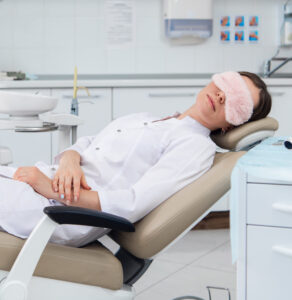Header logo
header top contact widget
Periodontist
Don’t Allow Dental Fear or Anxiety To Ruin Your Smile
Posted on Aug 23, 2023 by William J. Claiborne, DDS MS
It’s a proven fact that your oral health – the wellness of your teeth and gum tissues – is an influencing contributor to your overall health. For decades, researchers have studied the concerning risks, and alarming connections, between oral health and a number of serious diseases in the body.
The leading culprit in this scenario are the bacteria of advanced gum disease, known as periodontitis. Gum disease breeds bacteria that are inflammatory in makeup. Once they enter the bloodstream (through tears in disease oral tissues), studies have found these potent bacteria can trigger the onset of serious diseases, such as:
• Heart disease
• Stroke
• Alzheimer’s disease & Dementia
• Some cancers (including lung and pancreatic)
• Pre-term babies
• Diabetes
• Arthritis
• High blood pressure
• Erectile Dysfunction (ED)
As research continues, more and more findings are bringing to light just how connected the mouth is to the efficient operation of the immune system. During the Covid pandemic, it was well publicized that those most vulnerable to the virus were those who were immune compromised.
One study, conducted between February and July 2020, analyzed two groups of 568 total patients with severe COVID-19 complications (death, ICU admissions or assisted ventilation). Periodontal conditions in the two groups were analyzed. Of the patients studied, those with periodontitis were three times more likely to experience COVID‐19 complications including death, ICU admission, and the need for assisted ventilation.
For years, the cost of dentistry has been credited for preventing millions of American adults from having regular dental care. This was recently studied in a nationally representative survey of 5,682 adults. In this, researchers looked at knowledge, attitudes, experiences, and behaviors related to oral health.
Results from the survey show that lack of insurance is a leading reason for avoiding dental care or delaying recommended care (often until something becomes so painful that the individual is forced into a dentist’s chair seeking relief).
The study showed that 16% of adults without dental insurance admitted that they had not seen a dentist in more than five years compared to just 5% of adults with dental insurance. Forty percent of adults without dental insurance reported cost was the reason they hadn’t visited the dentist in the past two years, compared to 14% of adults with dental insurance.
Yet, excruciating pain from a dental problem can be the impetus for setting aside the cost. The same is true for people who have fear or anxiety associated with dental care.
About 36% of people in the U.S. have a fear of dental treatment, with 12% having an intense fear, known as dentophobia. Dental phobics are people who avoid going to the dentist at all. Dental fear is more common in females than males, with an estimated 3% of men and almost 5% of women having dentophobia.
Reasons for these fears include:
– Fear the anesthetic will not work or be sufficient to fully numb the pain
– Blood makes some people feel afraid or panicky about bleeding during a dental procedure.
– People may fear choking or gagging and not being able to breathe or swallow.
– For individuals who have had a poor experience with a dentist in the past, they may associate negative feelings with their dentist.
– Feeling pain from the procedure or recovery
– Some people are highly fearful of needles.
– The noise from drills and dental instruments used by a dentist or dental hygienist can create high levels of anxiety for some people.
– The same is true when it comes to certain smells that arise during dental treatment.
New Study Links Periodontitis and COVID‐19 Complications
At our Asheville NC periodontal dental office, we take patient comfort very seriously, and that goes for all patients at every appointment. We find that many patients have developed severe gum disease or had tooth loss because they were afraid of going to a dentist. This prevents people from having regular dental care, which allows small problems to become worse ones.
Many with dental fear or dentophobia avoid going to the dentist for years. And, these feelings may be more common than you know. When dental anxiety, dental fear and dentophobia are combined, it affects an estimated 70% of American adults. This unfortunate statistic is a likely reason for the high percentage of adults who suffer with some level of periodontal (gum) disease – over 47%.
As a Periodontist, my staff and I work diligently to pamper patients from the moment they enter. For certain procedures as well as for patients who prefer the addition of sedatives, we offer oral sedation as well as I.V. sedation (twilight sleep).
Oral sedation is a pill that helps patients relax. It also has an amnesiac effect, leaving most with little or no memory of treatment afterward.
I.V. sedation places the patient in a deeper sleep state, also erasing memory of the procedure. It is administered by a doctor of anesthesiology, overseen by Dr. Brad Stone, a Medical Doctor (MD) and a board certified Anesthesiologist & Pediatric Anesthesiologist.
https://www.biltmoreperiodontics.com/comprehensive-care-team/
With both sedation options, patients are closely monitored with advanced safety equipment throughout treatment.
If fear has caused you or someone you know to avoid dental visits, please arrange a consultation with us. In our Western NC periodontal dental office, you’ll find a warm, respectful atmosphere where your concerns are understood. During this time, we can discuss comfort options that may be best for your individual needs along with estimated costs.
Call 828-274-9440.
Beware of Hidden Contributors to Gum Disease, Tooth Loss
Posted on Aug 19, 2023 by William J. Claiborne, DDS MS
Decades ago, oral health was something many people took lightly, often waiting until something hurt to see a dentist. The fierce pain of a cavity or abscess or the sharp jolt of something hot or cold on an area of gum recession were motivators to for a dental visit.
However, Americans are now realizing how very important their oral health is in how it relates to overall health.
The correlation lies with bacteria that live within the gum tissues. While all mouths contain “good” and “bad” bacteria, research has determined that the bad type can cause problems within and outside of the mouth.
The bad bacteria are inflammatory. An accumulation of these inflammatory bacteria are what lead to periodontal (gum) disease. Gum disease is the nation’s leading cause of adult tooth loss. Additionally, advanced periodontal disease – periodontitis – can trigger or even worsen serious health condition far beyond the mouth.
Although gum disease can begin without any obvious symptoms, once it exists, progression occurs in three stages, which are:
• Gingivitis – As the initial stage of gum disease, inflammation is triggered by plaque buildup at the gum line. When daily brushing and flossing fail to thoroughly remove plaque, toxins form that cause irritation to the gum tissues. Once signs emerge, they may include seeing blood in the sink when brushing or having sore, swollen gums. At this stage, however, damage may be reversed with prompt response.
• Periodontitis – As the disease advances, the bone structures and fibers that support teeth are damaged by the destruction of infectious oral bacteria. At this stage, inflamed gums form pockets below the gum line, filling with bacteria-laden plaque.
• Advanced Periodontitis – In the advanced stage of gum disease, fibers and bone supporting natural teeth are destroyed. This can cause teeth to shift or loosen, requiring aggressive treatment to prevent tooth loss. Eventually, some teeth may require removal.
As devastating as tooth loss can be to one’s overall health, the bacteria of gum disease can enter the bloodstream. Research has shown this infectious bacteria can trigger inflammatory reactions elsewhere in the body, correlating to heart disease, stroke, high blood pressure, some cancers (including lung and pancreatic), diabetes, arthritis, impotency, preterm babies, Alzheimer’s disease and more.
Obviously, people should be highly-committed to the care of their oral health. Yet, statistics in America along these lines are not impressive. The Center for Disease Control’s Division of Oral Health cites that 1 out of every 2 American adults 30 and over has periodontal disease. They also shared that periodontal disease is higher in men than women (56.4% vs. 38.4%) with high prevalence rates among smokers (64.2%) and adults 65+ (70.1%).
In addition to your twice-a-year dental check-ups and cleanings, there are other ways to support oral wellness between visits. One is in keeping the mouth moist, supporting sufficient saliva flow.
When saliva flow is insufficient, bacteria are able to accumulate and multiply rapidly. In addition to oral dryness as a part of the aging process, contributors can be consuming alcoholic beverages, caffeine, and as a side effect of many medications (both OTC and Rx).
One reason to keep your dental professionals aware of ALL the medications your take is in how they can interact with certain procedures, including numbing agents. For example, medications to reduce blood clotting, which lowers your risk for stroke and heart disease, can cause bleeding problems during oral surgery or periodontal treatment.
For those who take medications that help to strengthen bones, these have been associated with a rare but serious condition called osteonecrosis of the jaw. Simply put, it refers to death of the bone. The risk of these prescriptions is greater for those administered by injection or intravenously.
Osteonecrosis of the jaw commonly occurs after dental procedures (tooth extraction, implant placement). Over 90% of those who have experienced osteonecrosis are those who have taken the medication in repeated high doses due to cancer or other diseases.
However, 10% who experienced osteonecrosis were taking much lower doses, mostly intended to treat osteoporosis.
Certain medications also affect the ability to taste, including cardiovascular agents, central nervous system stimulants, non-steroidal anti-inflammatory drugs, respiratory inhalants and nicotine skin patches.
Some medications can also cause the development of oral sores, inflammation or discoloration of gum tissues in the mouth. These oral sores or discolorations may arise from taking medications for blood pressure, oral contraceptives and chemotherapy agents.
Dry mouth is a common side effect of a wide variety of medications, including prescriptive and over-the-counter. These include antihistamines, decongestants, painkillers, high blood pressure medications, muscle relaxants, drugs for urinary incontinence, anti-depressants and many others. Drying causes the soft tissues in the mouth to become inflamed and makes you more susceptible to infection. When saliva flow is depleted, your risk for tooth decay and gum disease increases.
Supplements that may seem unconnected to your oral health can actually effect your care more than you realize. It is important for your dentist to know if you take…
• Ginkgo biloba or evening primrose – These herbs can reduce your blood’s ability to clot, possibly leading to excessive bleeding during and/or after a dental procedure.
• St. John’s Wort – This herb, which is often taken to reduce anxiety, can interfere with the metabolism of other medications, including sedatives, antibiotics and anti-inflammatory drugs such as prednisone and Decadron. When combined with St. John’s Wort, these drugs can be less effective. On the other hand, narcotics such as codeine, Vicodin and oxycodone can become more potent when taken with St. John’s Wort. This can lead to sleepiness, lethargy and dizziness.
• Valerian – This herb has mild sedative effects. If your dentist prescribes drugs for anxiety or painkillers containing codeine, the effects of both together are greatly accentuated. This can lead to severe sleepiness, lethargy and dizziness that can last into the next day.
• Calcium and magnesium – When these supplements are combined with certain antibiotics, they can decrease the antibiotics being properly absorbed. This can compromise your ability to fight off infection.
As a periodontal specialist, I find that most cases of dry mouth are due to factors that can be easily controlled with simple changes. If you have delayed or avoided dental care, call 828-274-9440 to request a consultation, or begin with a thorough examination in our Asheville periodontal office.
And, if you are experiencing signs of gum disease, please know this disease will only worsen without treatment. The sooner you have treatment, the less involvement your treatment will likely be.
We offer the latest techniques, technology, and skills while always making patient comfort a top priority. If dental fear or anxiety are concerns, please make us aware of this when you call or at your initial appointment. In addition to our standard comfort features, we offer Oral and I.V. sedation (“twilight sleep”).
How the “Bad” Bacteria in the Mouth Can Lead To Serious Health Problems
Posted on Aug 08, 2023 by William J. Claiborne, DDS MS
The human body is a fascinating structure. It seems every year there are new findings that show just how complex and amazing it is.
 Recently, one of the biggest areas of interest has been the study of microbiome in the body. Once thought to be icky little cesspools, these colonies of microorganisms are now seen as having an important role in our health. For example, the microbiome in the gut has been shown to aid in digestion and it’s now seen that skin microbiome may potentially help people overcome conditions like acne and eczema.
Recently, one of the biggest areas of interest has been the study of microbiome in the body. Once thought to be icky little cesspools, these colonies of microorganisms are now seen as having an important role in our health. For example, the microbiome in the gut has been shown to aid in digestion and it’s now seen that skin microbiome may potentially help people overcome conditions like acne and eczema.
As a periodontist, I’ve followed research in how microbiome is being recognized for having a positive role in oral health. While bacteria that convert sugar to acid are the driving force behind tooth decay, this means that those critters in our mouths are not always bad guys.
There are about 700 different species of bacteria in your mouth. Some can be “bad,” yet the good bacteria are able to give our overall health a “leg up” in certain regards.
Certainly, having a clean, healthy mouth helps to prevent cavities and periodontal (gum) disease. However, read on to learn how the health of your mouth can contribute to your overall health to a rather significant extent.
Over the years, numerous studies have been able to pinpoint how diseases – such as heart disease, diabetes, arthritis, and more – might be triggered. The “trigger” seems to consistently link back to internal inflammation.
Inflammation in the body has been shown to set actions into play that cause the onset or worsening of a wide variety of health problems. Periodontal (gum) disease is a chronic inflammatory disease. This means the bacteria attacking gum tissues are in a consistently active state.
When the bacteria of gum disease enter the bloodstream (through tears in weakened gum tissues), it can create inflammatory triggers far beyond the mouth. This bloodborne inflammation, in turn, results in higher risks for heart disease, stroke, diabetes, preterm babies, arthritis, respiratory diseases and even impotency.
How can this occur?
In chronic inflammation, the body’s defense mechanism becomes stuck in the ‘on’ position. This sets off a chain of reactions that alter the helpful response of the immune to a harmful one. When an area in the body stays in an inflammatory setting, damaging reactions can occur.
Once in the bloodstream, several species of harmful gum disease bacteria can add to existing inflammation, including that in the arteries, where it can lead to heart attack and stroke.
In one study of 265 stroke patients, researchers found that patients with gum disease had twice as many strokes (due to thickening and hardening of brain arteries) as patients without. Additionally, patients with gum disease were three times as likely to have a stroke involving blood vessels in the back of the brain, which controls vision, coordination and other functions.
In a separate study of over 1,100 patients who had not experienced a stroke, researchers noted that 10% had severely blocked brain arteries. They also found that patients with gum inflammation were twice as likely to have moderately severe narrowing of brain arteries.
Another example is in the similarities between tissues of gum disease and those taken from arthritic joints. Studies show that gum disease is not only a risk factor for arthritis (both are inflammatory diseases), one can contribute to the other. Thus, gum disease is a risk factor for developing RA and arthritic patients have a greater risk for gum disease.
Additionally, people with diabetes are more likely to have periodontal disease than people without it, likely because they’re more susceptible to contracting infections overall, according to the American Academy of Periodontology.
Studies also show that pregnant women with periodontal disease have a greater risk of having pre-term and low birth weight babies. These indications have been found in amniotic fluid and in fetal cord blood samples of infants.
Findings show, too, that the bacteria of periodontal disease may contribute to a higher risk of pancreatic cancer. For years, researchers at the National Cancer Institute and the American Cancer Society have conducted cancer prevention and screening studies.
By studying oral samples, notably higher levels of two types of oral bacteria were measured in study participants with pancreatic cancer. One oral bacteria was found to create a 50% increased risk for pancreatic cancer and the second oral bacteria led to a 59% greater likelihood.
Chronic inflammation, in any area of the body, is a health risk that poses severe health challenges now highly recognized in the medical field. Not surprisingly, we occasionally see patients who have been advised by their surgeons to have their gum health checked prior to surgery. This proactive measure is to reduce risk factors that could complicate surgical outcome.
Your body’s natural defenses along with good oral hygiene — such as daily brushing and flossing — helps to keep bacteria under control. Also, people should readily recognize the signs and symptoms of periodontal disease.
Healthy gums fit snugly around the base of teeth and be a light pink color. Although the initial stage of gum disease (gingivitis) may exist without obvious symptoms, common signs of gum disease include:
• Swollen or puffy gums
• Bright red or purplish gums
• Gums that feel tender or bleed easily
• Spitting out blood when brushing or flossing
• Frequent or persistent bad breath
• Pus pockets between some teeth and gums
• Loose teeth or a change in the way teeth fit
• Painful chewing
• Gums that pull away from teeth or are sensitive to heat and/or cold
Maintaining good at-home oral hygiene is easy and takes just minutes a day. Brush twice a day (two minutes each time) and floss daily. Drink plenty of plain water throughout the day and limit sugar. Have dental cleanings every six months and follow your dental hygienist’s recommendations to keep oral bacteria at minimal levels between visits.
If you suspect you have gum disease or have delayed (or avoided) having regular dental care, call our Asheville periodontal dental office to schedule an examination. Or, ask to begin with a consultation appointment. During this time, we can discuss any concerns and I’ll answer your questions. Call 828-274-9440.
Let’s help you achieve a healthy, confident smile that adds to the well-being of your overall health!
Sources:
https://www.jnj.com/innovation/4-things-scientists-know-about-the-bacteria-in-your-mouth
https://www.nih.gov/news-events/nih-research-matters/identifying-new-contributor-tooth-decay
https://pubmed.ncbi.nlm.nih.gov/26474422/
http://www.health.harvard.edu/press_releases/heart-disease-oral-health
https://www.cancer.org/research/cancer-facts-statistics.html
Grow Older With A Confident Smile That Is An Asset To Your Well-Being
Posted on Jul 27, 2023 by William J. Claiborne, DDS MS
Oliver Wendell Holmes, an associate justice of the U.S. Supreme Court from 1902 – 1932, once said, “Old age is always fifteen years older than I am.”
 For people who’ve reached “a certain age,” it becomes clear that the advantages of aging (such as having more confidence and living life at a slower pace) are mixed with many challenges, mostly regarding health.
For people who’ve reached “a certain age,” it becomes clear that the advantages of aging (such as having more confidence and living life at a slower pace) are mixed with many challenges, mostly regarding health.
From aching joints to loss of muscle strength to poor eyesight and hearing loss, the aging process comes with health challenges that seem to grow in number and severity with each passing year. Sadly, increased risk of tooth loss is also part of the process.
Depending on the retention of wisdom teeth, a full set of adult teeth should be 28 to 32. However, in a five-year study by the National Health & Nutrition Examination Survey, Americans ages 75 and over were missing over 22 natural teeth with over 26% having no remaining teeth (known as being edentulous).
While tooth loss is often perceived as a normal part of the aging process, it is not. Keeping one’s teeth throughout a lifetime is very possible. The health benefits of maintaining natural teeth include, among many others, living a longer life.
Healthy teeth rely on a healthy foundation — your gums. Good oral health has been shown to reduce risks for serious health conditions (including heart disease, stroke, and some cancers) elsewhere in the body. In addition to lowering a number of health risks, keeping your natural teeth is necessary for proper biting, sufficient chewing, digestional health and nutritional intake.
It has also been shown that wearing dentures is a poor method of replacing natural teeth. Even though they recreate the appearance of teeth and restore function (to varying extents), dentures can actually contribute to long-term problems.
Natural tooth roots help to nourish and stimulate the jaw bones that are the supporting structures of teeth. Without them, the bones begin to shrink. Known as “resorption,” this process of bone mass decline can eventually lead to tooth loss. Once resorption begins,, it continues at an ever-increasing cases year after year.
Tooth loss also causes a domino effect of sorts. Statistics show that adjacent teeth beside an area of tooth loss have the highest risk of being the next to be lost.
And the problems associated with dentures continue. The gum-colored base of dentures is porous. This surface provides oral bacteria with tiny hideouts that are breeding grounds for high levels of bacteria. Denture wearers have higher incidences of respiratory problems, including susceptibility to pneumonia. Studies have shown that senior adults who also sleep in their dentures have even higher risks.
Wearing your dentures for prolonged periods of time (such as while you sleep) coupled with the aging process itself can lead to Denture Stomatitis. This condition causes redness, swelling and tenderness in the mouth. While it is most common among denture wearers, it can also occur from a broad spectrum of antibiotics.
Nearly 89% of adults ages 65 and older report they are currently taking any prescription medicine. More than half of adults 65 and older (54%) report taking four or more prescription drugs (compared to 32% of adults 50-64).
While a number of both prescribed and OTC medications include the side effect of oral dryness for any age, age-related reductions in salivary production are more severe for older adults, causing irritation to oral tissues.
Medications including antihistamines, blood pressure medications, decongestants, pain medications, diuretics and antidepressants typically cause dry mouth, which can create inflammation and higher susceptibility to infection.
The aging process causes the condition of “dry mouth.” Saliva plays an important role in maintaining good oral health. A healthy saliva flow makes it easy to talk, swallow, taste, and digest food. A reduction in saliva flow can increase plaque accumulation as well as the risk of developing periodontal disease.
Referred to as gum disease, this bacteria accumulation can lead to tooth decay, mouth sores and oral infections. Inadequate saliva can contribute to bad breath, dry and cracked lips, cause the fit of dentures to become uncomfortable, and result in higher oral infection risk.
An emphasis on maintaining good oral health needs to be front and center for older adults along with their overall health care commitment. Fortunately, good oral health is easy to achieve. Twice-daily brushing, daily flossing and having 6-month dental exams and cleanings can help to minimize problems and address those that do occur at their earliest stages.
It is also important to keep your mouth moist. Drink plenty of water throughout the day. Limit foods and beverages that are caffeinated, which are drying to oral tissues. These include coffee, tea, colas and chocolate as well as spicy foods. If you take medications that have drying side effects, use an oral rinse designed to replenish moisture. Also, chew sugarless gum to help promote saliva flow.
Your diet is an important part of a healthy mouth. Evaluate your food intake carefully. Begin by limiting carbs and sugar. While all foods trigger an acid attack in the mouth for nearly 30 minutes after eating, sugar and carbs super-charge the reproduction of oral bacteria.
When teeth are lost, adults encounter a complicated set of issues – and costly challenges that can reach far beyond the mouth. As a Periodontist, I’ve seen how simple measures can save people greatly in treatment time and expense AND prevent problems like gum disease, cavities and tooth loss.
According to Woody Allen, “You can live to be a hundred if you give up all things that make you want to live to be a hundred.” Your smile should be one of your best assets throughout your lifetime, complementing appearance and as an advantage to your overall health. Don’t let the detrimental impact of tooth loss and risks associated with gum disease make you look and feel old.
If you have begun to lose natural teeth, let us help you halt the process! We can also discuss replacing them with dental implants with our specialized skills in the diagnosis and placement of dental implant.
Call 828-274-9440 to schedule a consultation to discuss how you can regain your oral health for a lasting, healthy smile!
Sources:
https://www.nidcr.nih.gov/research/data-statistics/tooth-loss/seniors
https://www.kff.org/health-reform/issue-brief/data-note-prescription-drugs-and-older-adults/
https://my.clevelandclinic.org/health/diseases/21702-denture-stomatitis
Recent Posts
Categories
Archives
- September 2024
- August 2024
- July 2024
- June 2024
- May 2024
- April 2024
- March 2024
- February 2024
- January 2024
- December 2023
- November 2023
- October 2023
- September 2023
- August 2023
- July 2023
- June 2023
- May 2023
- April 2023
- March 2023
- February 2023
- January 2023
- December 2022
- November 2022
- October 2022
- September 2022
- August 2022
- July 2022
- June 2022
- May 2022
- April 2022
- March 2022
- February 2022
- January 2022
- December 2021
- November 2021
- October 2021
- September 2021
- August 2021
- July 2021
- June 2021
- May 2021
- April 2021
- March 2021
- February 2021
- January 2021
- December 2020
- November 2020
- October 2020
- September 2020
- August 2020
- July 2020
- June 2020
- May 2020
- April 2020
- March 2020
- February 2020
- January 2020
- December 2019
- November 2019
- October 2019
- September 2019
- August 2019
- July 2019
- June 2019
- May 2019
- April 2019
- March 2019
- February 2019
- January 2019
- December 2018
- November 2018
- October 2018
- September 2018
- August 2018
- July 2018
- June 2018
- May 2018
- April 2018
- March 2018
- February 2018
- January 2018
- December 2017
- November 2017
- October 2017
- September 2017
- August 2017
- July 2017
- June 2017
- May 2017
- April 2017
- March 2017
- February 2017
- January 2017
- December 2016
- November 2016
- October 2016
- September 2016
- August 2016
- July 2016
- June 2016
- May 2016
- April 2016
- March 2016
- February 2016
- January 2016
- December 2015
- November 2015
- October 2015
- September 2015
- August 2015
- July 2015
- June 2015
- May 2015
- April 2015
- March 2015
- February 2015
- January 2015
- December 2014
- November 2014
- October 2014
- September 2014
- August 2014
- July 2014
- June 2014
- May 2014
- April 2014
- March 2014
- February 2014
- January 2014
- December 2013
- November 2013
- October 2013
- September 2013
- August 2013
- July 2013
- June 2013
- May 2013
- April 2013
- March 2013
- February 2013
- January 2013
- December 2012
- November 2012
- October 2012
- September 2012
- August 2012
- July 2012
- June 2012


